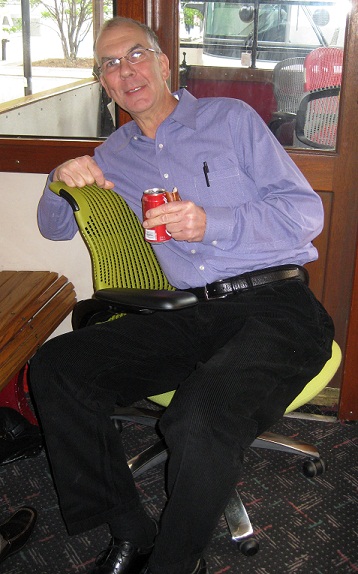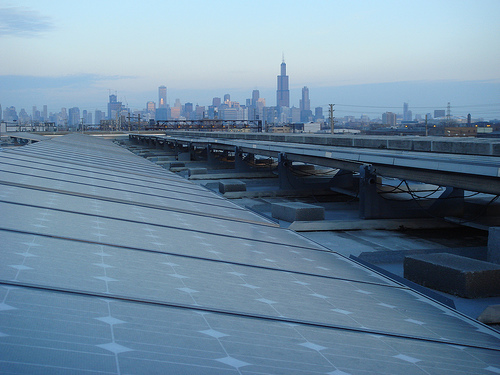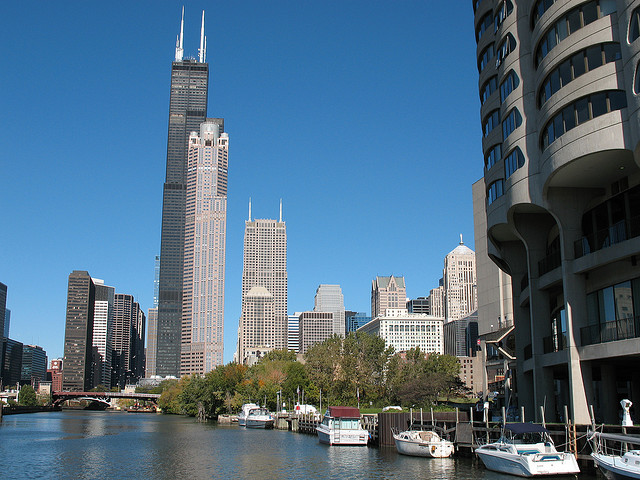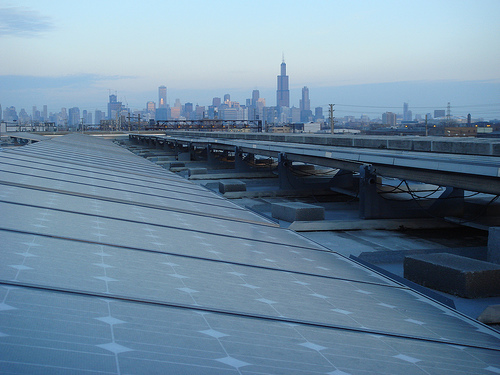 Photo: John AlbrechtToday, Chicago is overflowing with architects who know the ins and outs of the LEED rating system, but just a few years ago John Albrecht was one of the first. He worked on the Center for Green Technology — the city building that started it all -– as well as several green building projects that followed. He’s now in private practice, with the firm NELSON. He shared his thoughts on Chicago’s success.
Photo: John AlbrechtToday, Chicago is overflowing with architects who know the ins and outs of the LEED rating system, but just a few years ago John Albrecht was one of the first. He worked on the Center for Green Technology — the city building that started it all -– as well as several green building projects that followed. He’s now in private practice, with the firm NELSON. He shared his thoughts on Chicago’s success.
Q. Describe how Chicago got started with its green building initiative.
A. It was a confluence of events stated in the late ‘80s. It was a landscaping and beautification proposition that [Mayor Richard M. Daley] undertook. Over the course of those 10, 15 years, there was gradually more aggressive beautification and greening of the city with, literally, plants. We’re talking planters. We’re talking parkways. We’re talking baskets on buildings, on light poles. The city was transforming, and good things were being said about the city, and I think that altered his mind to taking it one step further when somebody mentioned green buildings.
At about that same time, there was a ComEd catastrophe where the city lost a significant number of elderly due to a heat wave. ComEd’s facilities failed in a number of locations. They settled the matter out of court for a large sum of money, which then went on to fund green buildings. It gave the city a pot from which to advance that cause. And the city had an advocate for green building in the mayor, and in the commissioner of the Department of the Environment. So they had the opportunity, and they had the interest.
And they had LEED come along. The LEED rating system was just arriving on the scene in pilot form. The mayor [was approached by the AIA] and agreed to try it out on a building on the West Side, and the building has come to be a showcase for LEED in the region.
That was about the time I came on the scene. I volunteered to be the architect test pilot, and got heavily involved. That building on the west side was a success in many regards, so the mayor decided to take it further with four more LEED buildings. I was involved in that, and in one of those buildings, I was the project manager.
Q. Was the primary motivation environmental protection, or did Chicago see this as smart for business development, and smart for the long term growth of the city?
A. The mayor’s looking out, ultimately, for the city. If this were a perfect world, everybody would be looking out for everybody at the same time. But in fact it’s a little territorial, and he’s looking out for the citizens of Chicago. What he found out was that the greener the city got, the more popular the city became, and the better the PR, and the more visitors, the more people want to move to the city — these are all good things. I would say it had a political, and an economic, and an environmental benefit. It’s created a legend that is unparalleled. What’s happened in the city of Chicago is phenomenal, and I give him full credit for that. Was it all about the environment? No, it’s all about the environment plus what does that do for my town.
Budget has been the big issue. That’s the Achilles heel of green buildings, right? There are additional costs involved. There are design costs in getting a green person on the team, and making sure the project’s as green as it can be. It takes some additional effort. Firms are doing that now, but back when the mayor started pushing it, it wasn’t commonly done.
Q. In terms of numbers, what do you mean? How much more expensive would a project be if you were taking a green approach?
 A view of downtown from the solar-panel-covered roof of Chicago Center for Green Technology.Photo courtesy of vyzl via FlickrA. It depends on how green the project is. The [Chicago Center for Green Technology], which is a showplace project for every green technology that can be stuffed into four walls, I honestly don’t know but I would guess that building was probably 50 percent [more expensive]. But on the other hand, how much payback has there been? They have several thousand people coming to see that building, in a neighborhood which wouldn’t see this otherwise. There’s buzz there, and they’re people put to work there in several programs. If you did a cost-benefit analysis, I say it would pan out.
A view of downtown from the solar-panel-covered roof of Chicago Center for Green Technology.Photo courtesy of vyzl via FlickrA. It depends on how green the project is. The [Chicago Center for Green Technology], which is a showplace project for every green technology that can be stuffed into four walls, I honestly don’t know but I would guess that building was probably 50 percent [more expensive]. But on the other hand, how much payback has there been? They have several thousand people coming to see that building, in a neighborhood which wouldn’t see this otherwise. There’s buzz there, and they’re people put to work there in several programs. If you did a cost-benefit analysis, I say it would pan out.
The same could be said of the green roof on City Hall. A million and a half dollars is a lot of money that didn’t need to be spent. You could have patched the roof. But I would argue, in hindsight, that you could not afford the good PR — if you to pay [a PR firm] for it in the marketplace — that project has brought the city. People come to the city and that’s on their list of things to do, and they’re disappointed they can’t get up there. There are prizes around the city and those are two of them.
How much more does a building cost, green versus traditional, is really the fair question, right? I would say anywhere from 2 to 5 percent, depending on how many green features it has.
Q. Were there zoning or code changes the city had to make?
A. They did make them. They didn’t have to, but they saw the benefits. That happened about the time Sadhu [Johnston, chief environmental officer for the city] arrived. That was one of the first things he did. He called a meeting on barriers in city code and zoning for green buildings. And as a result of a full-day, 50-person session, a long list was developed and it was filtered and crystallized over the course of a year. And subsequently the city launched its Green Permit Program, which found a way to reward green buildings both with quicker permits and some savings on the review end. As far as zoning goes, and planning goes, the city strongly encourages green building and rewards green building projects that come along with zoning approvals that are a little prompter, and maybe a little more beneficial to the developers. So the message is time and money. If I’m a developer, even if I’m not interested in saving the universe or the planet, I may do this just for the sake of time and money. The mission is to make it so tempting that it happens with or without good motives, and that’s okay with me, actually. I don’t have a problem with that.
Q. Is it easier to build from the ground up when you’re trying to be environmentally friendly? Wouldn’t it be better to make use of existing buildings?
A. Good question. If you’re demolishing a building and you do it thoughtfully and you recycle as much as possible, you might break even in terms of what’s better, one or the other. Generally, most of the demolition that occurs before a new building goes into the ground is kind of sad. But LEED encourages and rewards thoughtful deconstruction, recycling of product, reusing ground-up concrete, etc. I’d rather see us reusing our old [building] stock. That being said, it’s tough sometimes to make a building work to what you need it to work for
. Say, if you have a two-story police station that just isn’t big enough, you might spend more time and money than you would if you just demoed it thoughtfully — recycling and reusing, and doing it according to the program.
Q. What can other cities do to replicate what Chicago has done?
A. As a matter of fact, there has been a lot of replication done by other cities, including Boston. In 2005, 2006, the city of Boston sent a squadron to see what we were doing and how we were doing it. That is very common. Visitors come from all over the world to ring the mayor’s doorbell and want to find out how we did it.
ICLEI is an organization that’s all about local governments and it develops template-type approaches to sustainable this, that, and the other — templates that other cities can use — and they based a lot of what they developed on what happened her.
It’s had a big ripple effect already. The Green Building Council is very proud of Chicago. They’re coming here again for GreenBuild 2010. Nobody else has had two GreenBuilds. GreenBuild is a huge plum that the city is going to have had twice now. It speaks to the city, and what’s going on here, and the importance of it.
Q. Are people surprised that it’s Chicago — not Portland, say, or Berkeley?
A. That’s part of the charm. Chicago has the old square shoulders, kind of rough and tough, we’re going to figure this one out, we’ll solve this problem and we’ll do it with sweat and tears. And for this city to be thought of as more green than some of the softer shoulder cities, I think that’s a good thing. Compared to other cities that are — I don’t want to use the word flaky — a little further out, this city is grounded in how it does business, and thank you, it will stay grounded. For this city to be thought of as green paradise, as a mecca, that’s a dream come true.



